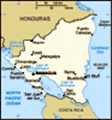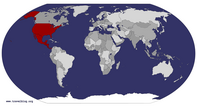Advertisement
Published: July 30th 2006
Intro to Leon
Watch a storm erupt over the cathedral in the plaza, with lightning illuminating the leonine statues guarding the entrance, and you're liable to think you are in an enchanted city. Many of Leon's proud residents would hardly disagree. They are the ones who work and live among the town's cobbled streets, tiny parks and neighborhood churches, and many of them can tell you more than the country's former capital than you'd ever learn visiting the many historic sites here. There is much to discover in Leon, and although its charms are subtler than those you might experience in Granada, for many Leon is the quintessential city of Nicaragua - vibrant and bustling, but deeply connected to the past.
History Leon was originally founded in 1524 by Francisco Fernandez de Cordoba at the site of the indigenous village of Imabite, near the foot of Volcan Momotombo, about 32 kilometers from where it stands today. In 1610, the volcanic activity triggered an earthquake that destroyed the old city. It was rebuilt near the existing indigenous capital, Subtiava, where it remains. Leon was the nation's capital from the colonial period until Managua took over the role in 1857. It was also the ecclesiastical center for both Nicaragua and Costa Rica. There are many fine colonial buildings and churches, including the impressive cathedral. Old Spanish-style house with stuccoed adobe walls, thick wooden doors and cool interior courtyards line the streets. The Universidad Autonoma de Nicaragua, Nicaragua's first university, was founded here in 1912. Traditionally Leon has been the most politically progressive of Nicaraguan cities. During the revolution, virtually the entire town fought against Somoza. Dramatic murals around town serve as reminders of that period, though many are fading. Only in two cities - Leon and Esteli - was the FSLN victorious in the 1990 and 1996 elections.
Our Experience
We arrived in Leon from Esteli around 5PM. We decided to take a taxi from the bus stop to a hostel our guidebook recommended called "Hotel La Cliníca." Our taxi dropped us off and ladies at La Cliníca opened the front door/gate for us. These ladies were amazing... just like sweet Southern ma'ams. They took us in and showed us a nice room upstairs with two beds, a private bathroom, and an all-important fan. (Interestingly, the bathroom had a toilet and a shower, but no sink!) We said we'd take it and they gave us the key. They also let us know that they sold bottled water, sodas, and breakfast in the morning.
After checking in, Joe and I went out to find supper. We settled on a local place just around the corner. Joe had chicken fingers complete with french fries and a soda. I had a chimichanga... that was good, but not the Tex-Mex style I'm used to back home. After dinner I went on a quest... for ice cream. The quest was disguised as a "let's walk around and look at some cathedrals and find and internet
cafe," but I gave myself away when my eyes lit up at the sight of an ice cream cart. After a delicious coffee flavored Junior Cone we played around on the internet and then went back to the hotel, showered, read for a bit, and slept.
We got up the next morning, had a great breakfast, and began our journey to the beach. We hopped a taxi that took us to the correct bus port, and pretty soon we found ourselves facing the Pacific Ocean. The waves were definitely bigger than those that I'm used to seeing on the Atlantic. We found a great rock to relax on a read for a while. After a bit, we relocated to a beach-side bar/restaurant and had some drinks and appetizers and just watched the ocean for a while. We got a few nice picures on a different part of the beach after leaving the restaurant, and we then headed back up to the road to catch the bus. Fortunately, we didn't have to wait too long, and we were soon on our way back. (While we were waiting for the bus we got to watch a young man shimmy up a
palm tree and pick some coconut looking objects. He was quite a coconut tree climber!)
By the time our bus arrived back in Leon and we taxied to Parque Central, it was time for dinner. We ate at a restaurant facing the park that we saw was pretty packed the previous night. Pretty packed is usually a good indication of a good restaurant (we hoped). It turned out to be a good choice. We found a internet cafe afterwards, checked email, updated some things, and finally went back to the hotel for the night.
The next day we decided to take another day trip from León to León Viejo (translated: Old León). León Viejo is where the Spanish originally founded the city of León, but sometime in the 1500s it was relocated to it's present location due to an earthquake. The original site of León, known as León Viego, was lost to time (and several volcano eruptions, earthquakes, and hurricanes). Only recently was the site rediscovered and excavated.
It took some tricky travel to get from León to León Viejo. According to our trusty guidebook, we were to bus from crossroads called La Paz Centro. From there,
we could supposedly catch a bus to León Viejo. Well... we made it to La Paz Centro without a hitch, but the bus from there to León evaded us. We sat at a bus stop for about half an hour watching various buses roll towards various destinations (none of which said appeared to be heading anywhere near León Viejo). After about 30 minutes, a guy who had recently arrived at our bus stop inquired as to our destination. I told him and he informed us we were at the wrong bus stop. Then, he flagged us a taxi and told the driver where we needed to go. I couldn't follow much of the conversation, but I gathered that the taxi would take us (for a reasonable sum) to León Viejo and from there a bus could bring us back to La Paz Centro. This seemed reasonable, so we bid our do-gooder farewell and hopped the taxi to León Viejo.
The ruins of León Viejo were somewhat unimpressive, especially after seeing the ruins of such great Mayan cities as Chichen Itza, Tulum, Tikal, and Copán. (A true testament to the superiority of Western civilization, eh?) Upon arriving in León Viejo
we were immediately assaulted by some extremely evil mosquitoes. Seriously, when these skeeters bit you felt it! It hurt! And then it itched. Not fun. After putting on some serious DEET bug spray things improved, but not much. We had brought two bottles of water (approximately 1 liter) with us, but it was very hot - and Joe is a pretty big fellow. He drank most of the water we had as soon as we arrived at the ruins. He kindly saved me... as he put it... "enough to survive." Enough to survive, in Joe's world, is apparently about 1 cup.
Joe's Note: Technically that was more than enough to survive given that there was a drink stand right around the corner outside the ruins 😊.
Ok.. ok.. enough of the dramatic. Aside from the mosquito and the H2O issue (which won't happen again, I assure you), the trip to León Viejo was indeed interesting. The ruins were simple enough (as colonial towns generally are). We saw the site of the original cathedral, the sites of some of the homes of several important governors and citizens of León, and we even climbed to a hill which used to
support the town's fort. The view from the site of the former fort was stunning. You could see for miles in almost every direction. As we were leaving the site, we happened to pass by the ruins of a house once occupied by none other than one Hernando de Soto and one Ponce de Leon! (I got my picture standing on the bricks of their old house!)
After visiting León Viejo, we got some drinks (yippee!) and walked back through the tiny pueblo (town) to the only paved road and waited for the bus. The bus arrived and took us back to La Paz Centro where we easily transfered to a bus heading back to León. Back in Léon we indulged in dinner at a guidebook-recommended restaurant, ice cream in the central plaza/park, and internet in a nearby cafe - then we went back to our hotel, showered, and slept!
The next morning we woke up late and decided to have a long, leisurely breakfast near the central plaza/park. After eating, we read for an hour or so and then took one last walk around León before gathering our bags and heading to the bus station. From León
we took an express bus (approx. 1 hr.) to Managua (the capital of Nicaragua). We arrived in Managua and took a taxi from to the terminal for buses heading further southeast towards Granada. From Managua, it was another 1.5 hr. to Granada, on the shores of Lago de Nicaragua.
Up Next
Granada... León's rival in Nicaraguan politics.
Advertisement
Tot: 0.09s; Tpl: 0.013s; cc: 10; qc: 46; dbt: 0.0432s; 1; m:domysql w:travelblog (10.17.0.13); sld: 1;
; mem: 1.2mb


















